Tourism has long been a key economic driver for Philadelphia—which is the 6th largest city in the U.S. and designated as a UNESCO World Heritage City. The Pennsylvania Convention Center (hereinafter Center), located in the heart of the Center City Philadelphia, serves as one of the City’s pillars in supporting the conventions and meetings industry. With typical visitor traffic welcoming over 1 million guests a year, the 2 million square foot Center helps drive $600 million worth of meeting and convention activity in Philadelphia. The positive economic ripple effect buoys business to the region’s hotel industry, dining and entertainment venues, retail stores, transportation commerce, and historical and cultural attractions. Supported by a collaborative quasi-government structure that represents city, county, and state stakeholders, the Center—a $1.3 Billion1 investment—serves as a critical regional economic engine, as well as a source of civic pride. The 2020 pandemic, and the associated downturn in convention and meeting business, served as an opportunity for the Center to upgrade and modernize the facility, enhance health and safety infrastructure, and redouble its commitment to sustainability and related CO2 emissions reductions. With a goal to modernize the facility and reduce operational environmental impact, plus offer visitors a safe, comfortable, and positive customer experience, the Center’s stakeholders wisely invested $15 million in infrastructure upgrades. The strategic upgrade plan included deploying state-of-the-art air purification and ventilation, technologies that lower water use, energy efficient LED lighting, new reflective roofing, expanded recycling, and streamlined management of HVAC, lighting, and power.
Siemens partnership provides expertise needed for digital transformation
To help convert this vision into reality, the Center decided to turn to its long-term technology partner—Siemens. Since the Pennsylvania Convention Center’s inception in 1993, Siemens has supported numerous multiphase, infrastructure improvement and upgrade projects. To help the Center implement its latest modernization and decarbonization initiatives, Siemens contributed technology and expertise in the following ways:
Energy efficiency
Through a Siemens Energy Services Conservation (ESCO) partnership, the Center was able to fund and finance energy-efficient products and services. For example, the Siemens Financial Services (SFS) organization was able to assist in the funding of new needlepoint bipolar ionization technology for air purification. SFS provided $15 million through a lease solution which included (The Center is always tax-exempt, we are state-affiliated facility run by an Authority) non-appropriation provisions to meet the Center’s needs. A guaranteed savings model was used across two phases of the project to fund $24 million in smart infrastructure investments (payments for the technology and services were funded through the resulting energy savings over time, so no large upfront payments were required).
Sustainability
The Center’s sustainability efforts involved multiple dimensions of their operation. Initiatives included water conservation, recycling within the food and beverage service areas, active energy management (more efficient light and temperature controls, insulation, weatherproofing), green procurement practices (prioritizing purchases from vendors who are committed to delivering high sustainability goods and offerings), a marshaling yard for convention related tractor trailers traffic(which results in significant CO2 emissions reductions through the avoidance of excessive back-and-forth site equipment delivery and removal), and efforts to migrate to clean energy sources (50% of the Center’s power supply is now derived from wind energy). The Siemens contribution to these efforts consisted of multiple digital solutions that enabled more sustainable day-to-day operations. For example, cross-facility smart building technology such as meters and sensors (for gathering electricity, gas, and water consumption data) and analysis software (for centralizing and interpreting that data and optimizing environmental controls to limit waste and maximize operational efficiencies) helped to build a solid foundation for energy savings and resource conservation. Process improvements implemented during Phase I of the modernization project resulted in $686,000 in operational cost savings through 2021. In addition, installing LED lighting throughout the Convention Center helped save 4.5 million kWh in annual power consumption. In addition, Siemens provided demand response and building control software to help cut energy costs and CO2 emissions. On the automated demand response side, the Center can now interact directly with the local electrical utility company to better manage energy costs. Suppose the utility company needs to address greater power demand across its grid. In that case, the Center can contribute by curtailing its energy use over specific periods in exchange for discounted energy prices. In this way, it helps to temporarily bring stability to the local grid when demand is high, such as on a very cold or scorching hot day, and pay much lower electricity rates in return. On the building controls side, a Siemens software front end (Desigo CC) enables integrated building automation system fault detection using advanced algorithms and machine learning to predict failures before they happen. This continuous automated commissioning capability improves equipment uptime, promotes timely preventative maintenance, and enhances occupant comfort.
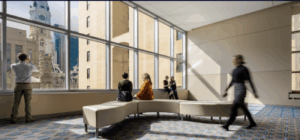
Images Courtesy of: Siemens
Resilience
Siemens also worked with the Center’s control and mechanical engineers and programmers to create a proprietary plant control solution that would enhance facility resilience through redundancy and reduce energy consumption. Although the facility hosts heating and cooling plants at both the East and West ends of their complex, those facilities had never been connected. The team developed a custom-engineered solution to control the integrated functioning of the two plants. Now the engineering team can run only one of the central plants to heat and cool the entire building when it is not fully occupied. Engineers can also choose which equipment is best suited to run based on the building’s requirements for that particular day. Integration of the two central mechanical heating and cooling plants enhances plant redundancy and reduces CO2 emissions. Now, 1.3 million kilowatt hours (kWh) of power is saved each year through interconnection and optimal use of one plant at a time, with a second plant already in place as a backup in case of unanticipated downtime.
Environmental controls
To ensure the highest possible indoor air quality and ventilation, the Siemens and Center teams engaged in a series of Variable air Volume (VaV) HVAC systems upgrades and performed the cleaning and sealing of HVAC ductwork and coils. These two initiatives have saved 200,000 kWh of energy and 1,900 thermal units of natural gas per year. In addition, the attachment of multiple Variable Frequency Drives (VFDs) to motors helped to save 530,000 kWh of power and 2,300 thermal units of natural gas. The combined energy efficiency, sustainability, resilience, and ventilation solutions reduced PCC baseline energy consumption by more than 18 percent.
High precision control drives visitor comfort and convenience
Besides these significant gains in energy efficiency and CO2 emissions reductions, the new digital solutions have also enhanced the flexibility of overall facility operations. Now, every meeting room, concourse, ballroom, and exhibit hall, can be individually monitored for air quality and temperature in real time. Sensors connected to the air handling units feed data into the control system, giving building managers real-time access to system performance data. The result is a total focus on air quality that emphasizes the health and well-being of visitors and of staff who work and do business in the Pennsylvania Convention Center. Digitalization of operations has also enabled visitors to view real-time building energy efficiency and air quality dashboards through large “green screens” that can be accessed from multiple locations within the facility. From a facilities data gathering and analysis perspective, the Siemens monitoring and control solutions help to support the Center’s facilities staff by tracking and modeling energy use and generating sustainability report metrics. Siemens artificial intelligence software also monitors chilled water, making necessary adjustments to conserve additional energy, and enables predictive maintenance by detecting potential issues before they result in unanticipated downtime. The Siemens team also periodically issues energy audit reports to ensure that all systems are optimized to achieve the highest performance levels.
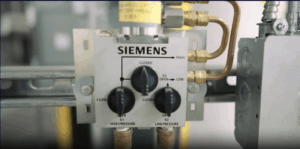
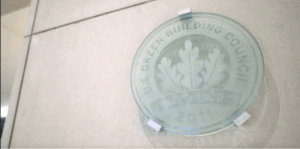
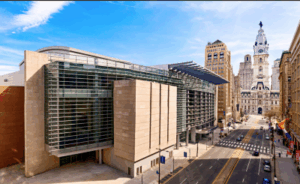
Images Courtesy of: Siemens
Decarbonization efforts spur global recognition and accreditation
Thanks to these long-term collaborative efforts, the Pennsylvania Convention Center has attained both a LEED Gold certification and Global Biorisk Advisory Council (GBAC) STAR™ certification. LEED is an internationally recognized green building certification system developed by the U. S. Green Building Council (USGBC). It provides building owners and operators with guidelines for implementing practical and measurable green building design, construction, operations, and maintenance solutions. The LEED rating system recognizes projects that develop and implement sustainable design strategies for better environmental performance. The Center began the Global Biorisk Advisory Council (GBAC) STAR certification process in 2020 and received the accreditation on outbreak prevention, response, and recovery in 2021. Recognized as the gold standard for safe venues, the Pennsylvania Convention Center is now one of the largest venues in the Northeastern U.S. to receive GBAC STAR™ accreditation. GBAC STAR™ Facility Accreditation identified the Center as a showcase example of commitment to ensuring a clean, safe, and healthy environment for its employees, customers, and stakeholders.
Conclusion
Future vision includes ongoing sustainability improvements. The Pennsylvania Convention Center’s modernization project has reduced baseline energy consumption by more than 18 percent and has helped to establish high level partnerships focused on sustainable operations. The ability to ensure visitor safety and comfort while maintaining high sustainability has been transformed from a vision to a reality. Ongoing sustainability investments will play an essential role in PCC’s future growth and development. With such smart building technologies in place, the Center can now serve as a blueprint for how other large buildings—arenas, performing-arts venues, museums, and more—can create action plans for infrastructure improvement upgrades that exceed industry standards for sustainability best practices.
Feature Image Courtesy of: Siemens
View the original article and our Inspiration here

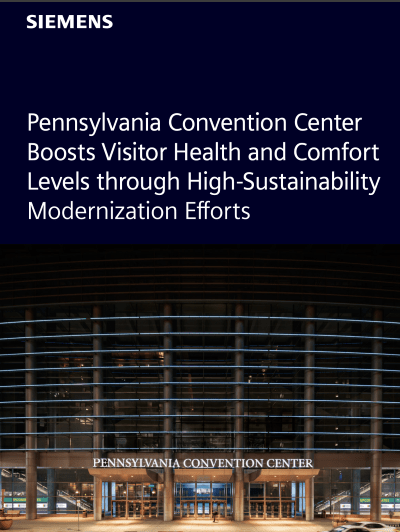
Leave a Reply